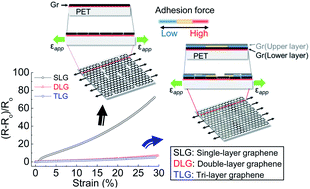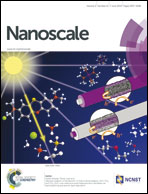Double-layer CVD graphene as stretchable transparent electrodes†
Abstract
The stretchability of CVD graphene with a large area is much lower than that of mechanically exfoliated pristine graphene owing to the intrinsic and extrinsic defects induced during its synthesis, etch-out of the catalytic metal, and the transfer processes. This low stretchability is the main obstacle for commercial application of CVD graphene in the field of flexible and stretchable electronics. In this study, artificially layered CVD graphene is suggested as a promising candidate for a stretchable transparent electrode. In contrast to single-layer graphene (SLG), multi-layer graphene has excellent electromechanical stretchability owing to the strain relaxation facilitated by sliding among the graphene layers. Macroscopic and microscopic electromechanical tensile tests were performed to understand the key mechanism for the improved stretchability, and crack generation and evolution were systematically investigated for their dependence on the number of CVD graphene layers during tensile deformation using lateral force microscopy. The stretchability of double-layer graphene (DLG) is much larger than that of SLG and is similar to that of triple-layer graphene (TLG). Considering the transmittance and the cost of transfer, DLG can be regarded as a suitable candidate for stretchable transparent electrodes.


 Please wait while we load your content...
Please wait while we load your content...